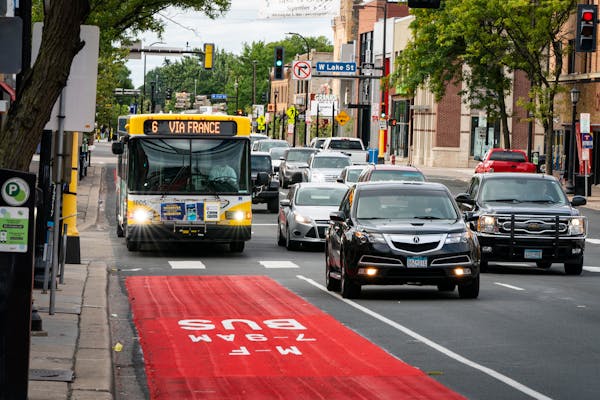Ridership aboard Metro Transit buses, trains and other public transit services surged by nearly 20% through April compared to the same period a year ago, although the numbers still aren't close to pre-pandemic levels.
"We continue to climb the hill of ridership as we recover from the pandemic," said John Harper,manager of contracted transit for the Metropolitan Council, which operates Metro Transit and Metro Mobility services.
All told, nearly 15 million rides were provided on buses, rail, Metro Mobility and other shared-ride services in the first four months of the year, according to a presentation at the council's Transportation Committee on Monday.
Met Council officials say the numbers indicate a steady return of passengers after ridership was decimated during the COVID-19 pandemic. While more people are using public transit as they head back to the office and travel to special events such as the Taylor Swift concerts and Pride festivities last month, overall ridership is only about 60% of what it was before the outbreak.
But transit officials say recently enacted safety measures, such as more police officers riding aboard the Blue and Green line light-rail trains, helped make passengers feel more secure. Last year, crime throughout the Metro Transit system increased by 54% over the previous year, with nuisance issues — such as drug and alcohol use and weapons offenses — surging by triple digits.
"We've taken deliberate and intensive action to foster an environment of safety on transit," said Metro Transit Police Chief Ernest Morales III, a New York City police veteran who assumed the department's helm in March. "We're not saying it's perfect, but we're working on it."
Clearly, the star performer was ridership on Metro Transit's growing bus rapid transit (BRT) system. During the first four months of the year, it increased 143% over the same period in 2022 to 2.1 million rides. Currently five BRT lines are operating in the metro, with seven more planned through 2030.
The Red and Orange lines operate along Cedar Avenue and Interstate 35W, respectively, and the A, C and D arterial BRT lines serve neighborhoods in Minneapolis and St. Paul as well as several eastern and northern suburbs.
Arterial BRT service features buses operating in traffic, with signal priority at intersections, and passengers paying before they board, making for a speedier trip.
Ridership on the D Line, arterial BRT service that began in December between Brooklyn Center and the Mall of America, was so robust that the number of rides was about even with pre-pandemic levels.
The Met Council is planning five additional arterial lines throughout the metro in the next five years. One of them, the B Line connecting Uptown to Union Depot in downtown St. Paul along Lake Street, Marshall and Selby avenues, is under construction, with service beginning late next year.
"Everything that we're thinking about building with these projects is designed to be faster, more reliable and make the service easier to use for customers," said Katie Roth, Metro Transit's director of arterial bus rapid transit, at a Met Council meeting last month.
However, ridership through April on the workhorse of the Metro Transit system — local buses that stop frequently — increased just 3% to 7.3 million rides. And ridership on express buses — largely between suburbs and the urban cores of Minneapolis and St. Paul — was essentially flat, a nod to monumental changes in transit use related to the rise of remote work during the pandemic.
Another suburban mode of transit, the Northstar commuter rail between downtown Minneapolis and Big Lake, saw its weekday ridership increase 29%, but only 28,153 people used the service through April.
Service on the Northstar Line was slashed during the pandemic to just four trips on weekdays and no trips for special events such as Twins games. All told, Northstar ridership is down about 88% from pre-pandemic levels.

Want to share info with the Star Tribune? How to do it securely

'Safe recovery sites' would offer syringes, naloxone and more to people using drugs. The plan could be in peril.
New Minnesota GOP leaders seek peace with party's anti-establishment wing

Who is Republican Lisa Demuth, Minnesota's first House speaker of color?

